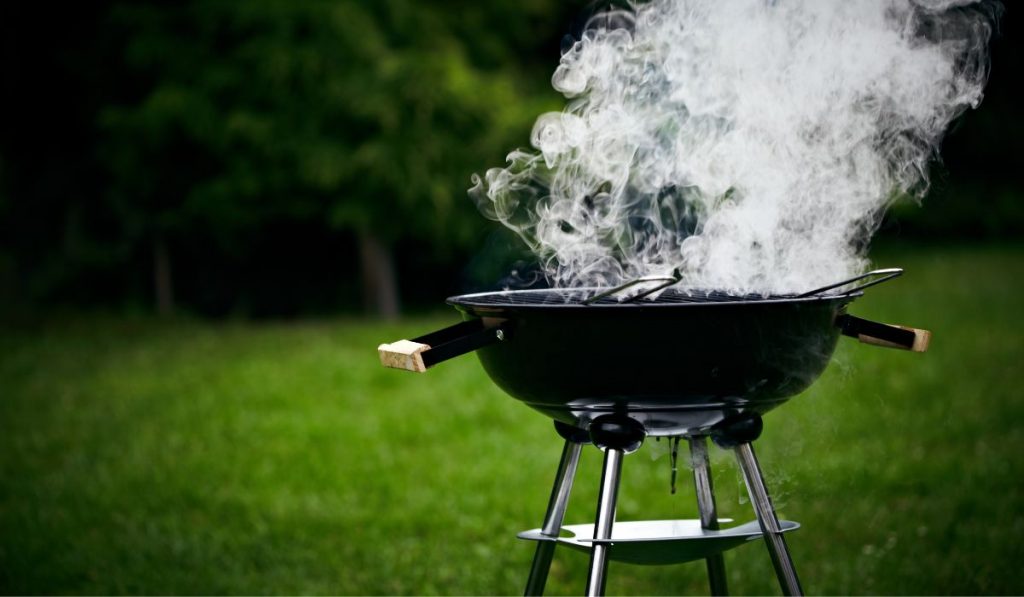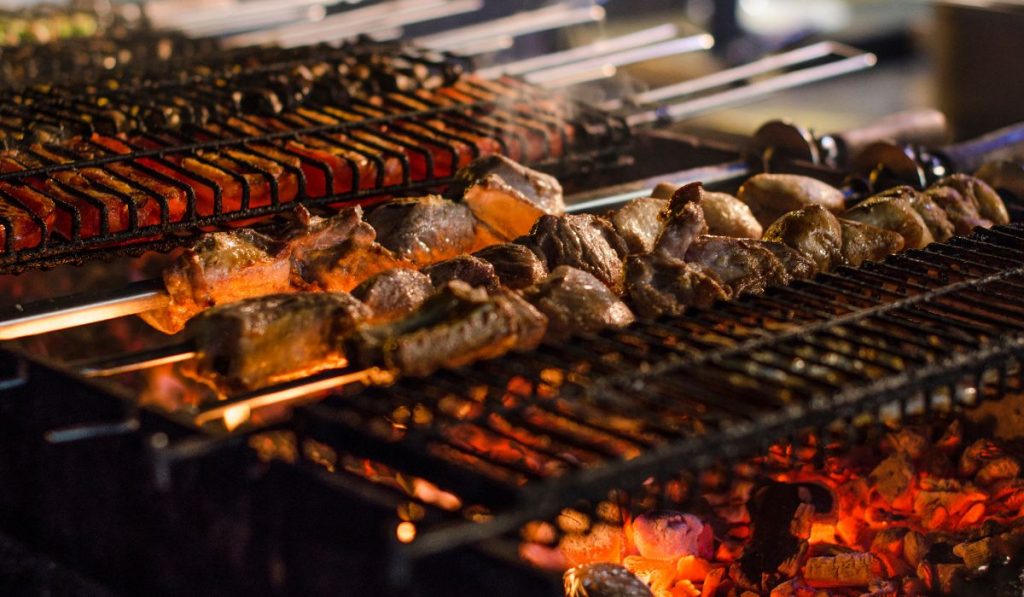Longing for the beginning of the warm season and the barbecue it brings ? Grilling is perhaps one of the most enjoyable parts of the warm season, and it’s definitely something we all miss when the cold rolls in. Until we can grill though, let’s take a look at who invented the grill and when, and the various methods we have at our disposal.
The earliest version of the modern grill was the kettle or Weber grill made by George Stephen, an American inventor, and founder of Weber-Stephen Products Co. In 1951 Stephen developed the kettle grill by cutting a buoy in half, welding on three legs and attaching a lid for the top. The grill hit the market in 1952 and was a huge hit.
However, the charcoal briquettes used for grilling were invented by a team made of Thomas Edison, Orin Stafford, and Edward Kingsford, who worked very closely with Henry Ford.

Ford was unhappy about the amount of leftover wood chips from the timber used in manufacturing the cars, Orin Stafford came up with the idea of how to make charcoal briquettes, Thomas Edison designed the factory to make them, and Kingsford oversaw the construction and later ran the factory.
This was in 1920, and the briquettes were often sold alongside portable grills (similar to gridirons), something called “Picnic Kits” and marketed by Ford (in the mid-’30s). Popularity of these grills wasn’t very high since most people still lived in urban areas and didn’t have the time or place to grill.
Modern grills have many contributing people
As with any invention, there was never just one man with an idea. There were many people who improved upon an existing idea, some who came up with competing grill versions in the same time frame, and marketing had a significant impact on consumers at the time. Let’s take a look at the various key contributions that added up and gave us modern grilling.
Charcoal For BBQ or Charcoal Grills
The gridiron is the idea behind grilling in the first place, and this concept is at least as old as the Roman Empire.
To grill, you often need a charcoal briquette. Those were dreamed up and put into practice by a team made up of Thomas Edison, Orin Stafford, and Edward Kingsford, who all worked with and for Ford.
Who Invented the Gas Grill?
The gas grill was a late 1930s invention made by Don McLaughlin. This is the early version of the LazyMan.
The idea of a closed grill was improved upon by George Stephen, who created the kettle grill (later known as Weber grill) in 1952.
Marketing wizards were responsible for heavily marketing the idea of grilling at home, in the comfort and privacy of your own backyard. Once WWII was over, grilling at home became more popular as suburban areas grew in population, the Weber grill became common, and marketing efforts at the time proved successful.
When was the grill invented ?
The closest version of the modern grill is the Weber kettle grill, invented by George Stephen in 1952. He later went on to found Weber-Stephen Product Co. He was also founder of Weber-Stephen Products Co.

However, the oldest version of something similar to the modern grill is the gridiron, a folding iron grid that usually forms crosshatch marks. Food is placed in the gridiron and secured, then cooked over an open flame or heat source. The earliest example of this was found in Pompeii, in ancient Italy (at the time the heart of the Roman Empire).
Over time gridirons, and the logic behind them was used for centuries, but it wasn’t until the 1800s when gridirons were patented across the U.S. These versions of a gridiron also featured legs, so you could place them in a fireplace and let them stand there while the food was cooking.
Meanwhile, a setup somewhat similar to a grill was found with the Taino people, an indigenous Caribbean civilization present when Columbus made first contact. Their method of grilling was a little different, and it entailed slow cooking meats over an open fire, in a pit that was covered with agave leaves. The resulting meat was a combination of smoked, roasted, and steamed.
The Taino name for this method of cooking was barbacoa, which is in fact the root of the word barbecue. I think it’s safe to assume that in time the word barbecue came to be applied with most cooking over an open flame, which later blended in with the use of the gridiron.
Why was the grill invented ?
The modern grill was invented to keep the wind from blowing ash into the food, hence the rounded semi-spherical shape, and the option to close the lid. Or so the story goes for the invention of the kettle grill the most common and popular.
The idea behind grilling as a cooking method is likely far older than that. Grilling gives you the advantage of cooking over a heat source or open flame, and most of the time used a gridiron, which is portable. This meant grilling could be done anywhere a fire could be started, and the cooked food was more secure in and on a gridiron than on a spit roast.
There are several types of grills and grilling methods
Grilling generally refers to the act of cooking outdoors, over a heat source, and over a metal grid, resulting in those lovely cross-hatch marks left on the food. However outdoor grilling isn’t the only version of grilling. It’s perhaps the oldest, but not the only one. Here’s a quick rundown of the key versions of grilling.
Most grills use a version of a gridiron, and cook over dry heat
Outdoor grills use a heat source, but never open flame. Whether it’s a pellet grill, wood grill, charcoal grill, gas grill, or infrared grill, the result is the same. Food is cooked onto the grill, with the lid closed or open, and in some cases this also results in a smoked, charred flavor (usually if using wood or charcoal).
The heat comes either from below the food, or if the lid is closed, from below and then radiates within the grill and cooks the top and side of the food as well. This is what most people refer to when they think of grilling, and it’s perhaps one of the most flavorful methods to cook your food.
Grill pans are a stovetop alternative to outdoor grilling
Grill pans are an alternative to grilling, without the char flavor since there is no charcoal or wood involved. A grill pan is similar to a regular, flat pan but has rows of raised metal ridges, and the heat comes from under the food. The top part is not cooked, so it must always be flipped at least once.

Grill pans are a great way to get the look of a grilled meal in a much shorter time than an outdoor grill. The flavor is nowhere near the one of outdoor grilling, but there can still be some char marks on the food that might remind you of a classic grill.
Griddles are another stovetop method that emulate grilling
Griddles can be flat, wide pans with shallow edges, or an entire cooking top that is completely flat (think flattops in restaurants). Cooking on these flat surfaces provides extreme heat from directly under the food, but doesn’t leave any grid marks as a grill or grill pan would.
This is one of the two ways to cook and assemble burgers, for example. Especially when the burger in question also contains cooked items like chopped sauteed onions, mushrooms, and even a slice of seared tomato.
Grilling in the oven (broiling) is more common in some places
In UK and Ireland grilling is actually done in the oven. The oven has a heat source at the very top, and the resulting food is cooked partly from above and partly from the radiating heat in the oven. This doesn’t result in a smoky flavor, but can char your food if you use high enough heat or leave the food under the grill for long enough. In other parts of the world this is referred to as broiling.
Read Also: Who Invented The Dishwasher?
George Foreman grills are derived from classic grills
When the Gorge Foreman grill came about (mid-90s), it was intended to be a method of indoor grilling that could cook both sides at the same time, as opposed to outdoor grills and grill pans that can only cook on one side. The design is similar to a gridiron, in that it opens and closes to keep food in, but these grills resemble a closed clam so the heating element can evenly distribute heat on both sides.
It also has raised ridges to emulate the charred look of a classic grill, and it’s also debatably inspired by the panini press which also opens and closes but does not form a fully closed object. Paninis were popular and already served at restaurants in the early ’80s.

